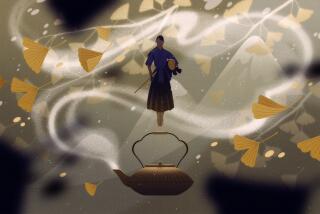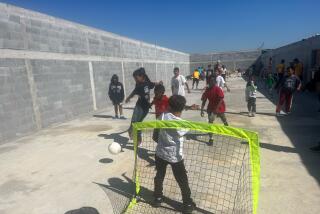Self-Defense Experts Teach Avoiding Violence by Staying Calm : ‘I’m teaching kids how not to get into fights’
- Share via
SAN DIEGO — In a room full of shadows, 18 children are kneeling in a row. Silently.
The oldest is 12, the youngest 5. Their eyes are closed. Soft music drifts in from a cassette player as the deep voice of their aikido instructor, Martin Katz, urges them to: “Keep focusing on your breathing . . . imagine you are breathing in the music . . . let the music take you somewhere else . . . someplace very wonderful; someplace you really belong . . . “
Nobody moves. Not an eyelid flickers.
Eighteen silent children? Is such a thing possible?
“Very possible, with Martin. He’s magical with the kids. A Pied Piper man,” Charles Wilburn murmurs as he watches his 7-year-old identical twin sons, Dorian and Ashlin.
The training hall--known as the dojo --is 60 by 65 feet. At 4:30 on a hazy June afternoon, the glimpse of Ocean Beach from the patio at the end of the hall shows a few droopy palm trees against a porridge-gray sky.
“The thing that impresses me about these classes is that when Matthew comes home, he’s so calm,” Matthew’s mother, Margot Laue, says. Matthew, she adds, is 8.
Katz, who is in his mid-30s and has a master’s degree in drama from San Diego State University, has been teaching aikido to children since 1978.
It’s a martial art. Used only for self-defense, it is based on having respect for oneself and for all living things. A trained aikidoist is like an escape artist. If attacked, he or she can blend with the attacker’s body movements in such a way that the violence is dissipated.
“A lot of my children start classes with the wrong idea about what they’re going to learn,” Katz said. “They’ve seen martial-arts movies where the hero takes on a dozen other guys with those dramatic flying kicks. And he keeps it up for hours, unconscious bodies littered all over the place. I’m teaching my kids how not to get into fights.”
Learning aikido takes years. (Katz trained from 1974 to 1978 to get his first-degree black belt.) It also involves a lot of physical action.
“But lots of physical action is great in a 90-minute class for children,” Katz said as he set the children rolling across the thickly matted floor. Rolls, he explained, are part of their training in how to fall without getting hurt.
Eighteen small bodies hurtle around him. The dojo rings with thumps, with the slap of bare feet. Their white, pajama-like gis flash as they roll past the shrine, where a photograph of aikido’s founder, Morihei Uyeshiba, gazes down from above a bowl of incense and a pot of scarlet geraniums.
“Rolling if you fall becomes automatic. I remember the night I realized it had become automatic for me,” he said. “I was coming home from a class late, down a dark road, and I tripped into a freshly dug irrigation ditch. I rolled instinctively. ‘Hey,’ I thought, ‘I’m not even bruised. This aikido ‘ s pretty good stuff!’ ”
Nobody, he says, teaches aikido quite the way he does. He moves among the children as they scramble to their feet. He makes faces at them. He makes exaggerated gestures. A wild “wheest wheest” sound--like a sword whistling through the air--emerges from his lips, followed by a parody of Japanese speech, the kind immortalized on “Saturday Night Live” as “John Belushi--Samurai Warrior.” The children hang around him in clusters, laughing.
Katz’s clothing--the gi worn under the ankle-length black skirt called a hakama-- looks straight out of an ancient wood carving. But his face--bearded with light-blue eyes gazing through gold-rimmed glasses, is definitely that of a third-generation American. One whose great-grandparents, on both sides, fled Eastern Europe to avoid a long-ago pogrom.
In the Long Island neighborhood in which Katz grew up, his father was known as the Pied Piper because he was so often surrounded by children.
Katz isn’t a father himself. He isn’t married. But ever since he moved to San Diego 13 years ago, he has, like his father, been surrounded by children.
Ten years ago he was a counselor and houseparent at Project Oz, an Escondido residential home for runaway adolescents. (“I used to use the aikido breathing exercises to help the kids there get to sleep,” he said. “A lot of them had trouble sleeping.”)
Later, as a graduate assistant in SDSU’s drama department, he traveled around California performing in children’s theater shows.
“We’ll have a little drama,” he called out to his class. They have a lot of little dramas. Today it’s a demonstration, acted out with class volunteers, of a man with a gun demanding money.
The children agree with Katz that it makes more sense to give up your wallet than fight. What is money compared to your health? Or life?
And if he comes at you with a knife?
Using the oldest student, a boy of 12 who is as tall as the teacher (“I’m a very tall 5-foot-7,” Katz said.), he demonstrates how an aikidoist can change the direction of an attacker with a knife. Aikidoists do not, he stresses, look for trouble. But enough is enough.
“What’s the highest form of aikido ?” he asks the children. “What’s the most important thing?”
Even the youngest student, 5-year-old Therese McBean, knows the answer. It is staying calm.
“Always stay as calm as you can around any person who threatens you,” Katz tells the children. “Or in any emergency situation. Being calm has a calming effect on other people.”
That is, he concedes, easy to say and difficult to do. “If you come home from school and find your mother unconscious on the kitchen floor, it’s normal to panic.”
To help the children stay calm in emergencies or dangerous situations, Katz teaches them how to be “centered,” how to focus their mind and energy onto a single area of the body.
Centering can be helpful in many areas of their lives. Matthew Laue’s mother remembers her son coming home from a baseball game and telling her he had been struck by the ball. “He said it hurt a lot . . . but he tried to focus, and it made the pain lessen,” she said.
Taken to its highest form--as the founder of aikido , who lived until 1969, did--centering can be incredibly powerful.
“I once saw a movie of him where he resisted five men who were pushing against his head,” Katz said. “They were grunting with effort, but they couldn’t move him a fraction of an inch.”
Aikido was unknown in this country before the 1960s. Now, Katz estimates, 1 million people practice it throughout the world, many of them in Southern California. There is an aikido master teaching in North Park. Two more sensei (the name for a martial-arts instructor) are teaching in Cardiff. Katz began his own training at San Diego City College.
“But there still aren’t many aikido instructors who teach children,” he said.
Recently, the Sunset Cliffs Aikido dojo was visited by a Japanese grand master, Morihiro Saito.
“A man with an 8th-degree black belt,” Katz said. “Incredibly advanced. The night he talked to us there were 150 people here, all kneeling on the floor. I heard him say, ‘If you can teach aikido to children, you can teach it to anybody.’ I thought, ‘Right on, sensei! Right on.’ ”
Katz teaches adults, too, at University City’s recreation center. He teaches a couple of children’s classes there as well. He never advertises, but he has trouble keeping the numbers down.
“The summer months are always less crowded,” he said. “But in winter--wow! My friends keep telling me I should expand, but . . . “ He shrugged.
A stray beam of early-evening sunlight appears suddenly and glints off the gold rims of his glasses. As well as aikido , he says, he’s teaching drama at Grossmont College this summer. A dream of his is to own a combined theater and aikido training school. Another thing he thinks about is getting a grant to teach his skill in public schools. “Then I could reach as many kids as possible.”
The main thing Katz tries to give each child is a positive attitude.
“It’s working. I come here twice a week, and I see him building self-respect in these kids,” Charles Wilburn, the father of the twins, said as the class neared its end.
The children are lined up in a row again, bowing to their sensei. Outside, on Santa Monica Avenue, a teen-ager on a skateboard whizzes past the open door of the dojo, creating an odd sense of time and cultures blending.
“My wife and I are hoping the inner strength the kids are developing here will help them resist negative peer pressure later on,” Wilburn said. He smiled. The results of the class are worth the time he spends driving the boys over from Mira Mesa, the hours spent watching from a hard wooden bench, he said. “Speaking as a parent, I’m just tickled pink about it!”


